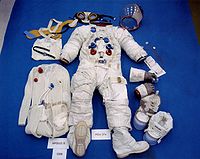
Photo from wikipedia
A previously developed joint-space metabolic energy expenditure (MEE) model includes subject-specific parameters and was validated using level walking gait data. In this work, we determine how well this joint-space model… Click to show full abstract
A previously developed joint-space metabolic energy expenditure (MEE) model includes subject-specific parameters and was validated using level walking gait data. In this work, we determine how well this joint-space model performs during various walking grades (-8%, 0%, and 8%) at 0.8 m·s ⁻1 and 1.3 m·s ⁻1 using published gait data in the literature. In response to those results, we formulate an optimization problem and solve it through the particle swam method plus fmincon function in MATLAB to identify a new optimal weighting parameter set for each grade that produces more accurate predicted MEE and we compare our new findings with seven other MEE models in the literature. The current study matched the measured MEE the best with the lowest RMSE values for level (0.45 J·kg ⁻1·m ⁻1) and downhill (0.82 J·kg ⁻1·m ⁻1) walking and the third lowest RMSE value for uphill (1.56 J·kg ⁻1·m ⁻1) walking, where another MEE model, Looney et al., had the lowest RMSE for uphill (1.27 J·kg ⁻1·m ⁻1) walking. Bland-Altman plots and three independent-samples t-tests show that there was no statistical significant difference between experimentally measured MEE and estimated MEE during the three walking conditions, meaning that the three new optimal weighting parameter sets can be used with 6 degree of freedom (DOF) lower extremity motion data to better estimate whole body MEE in those scenarios. We believe that this work is a step towards identifying a single robust parameter set that allows for accurate estimation of MEE during any task, with the potential to mitigate a limitation of indirect calorimetry requiring lengthy steady state motion.
Journal Title: PLoS ONE
Year Published: 2022
Link to full text (if available)
Share on Social Media: Sign Up to like & get
recommendations!